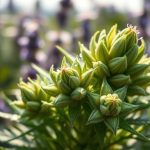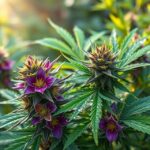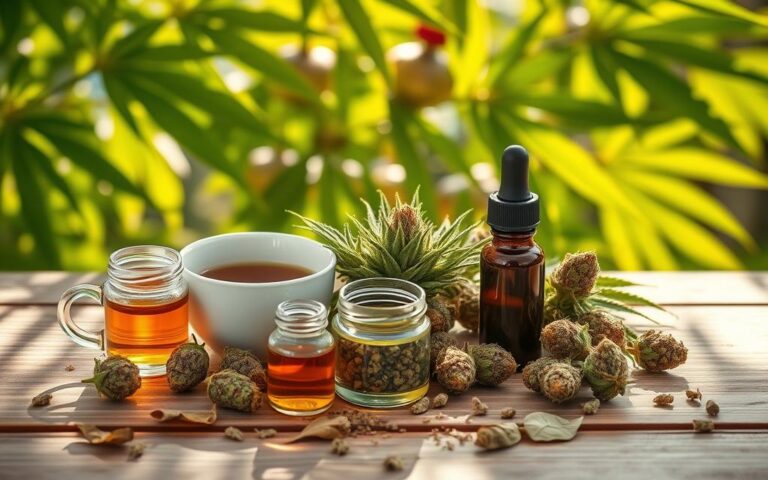CBD Flower vs Biomass: What Sets Them Apart?
In the world of cannabis, knowing the difference between CBD flower and biomass is key. CBD flower is the smokable part of the plant. It’s full of cannabinoids and has many flavours and effects. It appeals to those seeking relief through cannabinoids like CBD. Biomass includes the whole plant, like leaves, stems, and buds. It has varying strengths depending on its quality.
CBD flower and biomass are used differently. CBD flower is ready to use. Biomass is mainly for extracting CBD. For example, low-grade biomass has a 5-15% potency. High-grade biomass can have 15-25%. The potency depends on trichome density and the plant’s make-up. Bad things like contamination, mould, and pests can lower biomass quality. Testing is very important. There’s a move towards vertical integration to control biomass quality.
We’ll now look closer at each type. We’ll explore their unique traits and how they’re used.
Understanding CBD Flower
The CBD flower market has grown quickly in recent times. This growth is due to more people wanting smokable CBD products. High-quality CBD flowers are popular for their special characteristics and a wide range of cannabinoids.
The Role of CBD Flower in the Market
With a CBD content of 14% to 22%, CBD flower is a key player in the market. It offers a better smoking experience than CBD biomass, which has lower CBD levels. CBD flower must have less than 0.3% THC to meet the 2018 Farm Bill’s rules. Because of this, high-quality smokable CBD can be sold for much more than biomass.
Key Characteristics of CBD Flower
CBD flower stands out due to its rich cannabinoid and terpene content. These not only offer unique smells and tastes but also support the “entourage effect” of full-spectrum CBD oil. Grown in controlled settings, high-quality CBD flowers maintain a purity that biomass can’t match.
| Feature | CBD Flower | CBD Biomass |
|---|---|---|
| CBD Content | 14% – 22% | 8% – 14% |
| THC Limit | ||
| Price Point | Higher | Lower |
| Consumption Method | Smokable CBD | Processing for oil or isolate |
| Aroma and Flavor | Rich due to terpenes | Less pronounced |
| Quality Control | Stringent | Moderate |
What is Biomass?
Biomass is vital in cannabis production. It includes the non-flower parts of the plant, like stems and leaves. These are used for making extracts. Knowing what makes up cannabis biomass helps create top-quality extracts.
The Composition of Biomass
The makeup of cannabis biomass matters a lot for extract quality. High-quality biomass has lots of trichomes, which are great for CBD. But low-quality biomass has fewer trichomes, leading to not-so-good extracts. To get biomass ready for extraction, it needs careful drying and grinding. This helps keep extract quality high.
Importance of Quality in Biomass
The quality of biomass really counts when making extracts. Bad quality biomass can make low-quality concentrates. This can affect how safe and enjoyable the product is for users. It’s key to test biomass for bad stuff like mould or pesticides before and after making extracts. Using good-quality CBD biomass makes for a purer extract. This shows how crucial quality is, right from the start to the end of making cannabis products.

The Extraction Process: CBD Flower vs Biomass
The process of extracting CBD differs greatly between CBD flower and biomass. Each approach has unique steps that affect the final product’s quality and effectiveness.
Steps in Extracting CBD from Flowers
Extracting CBD from flowers is a detailed process that aims to keep the cannabinoids intact. The main steps are:
- Selecting the Best Buds: It starts with picking the best hemp flowers. These are known for their high cannabinoid levels.
- Drying: The flowers are dried in controlled conditions. This ensures the right moisture level for effective extraction.
- Processing: Methods like CO2 or ethanol extraction are used. Each has benefits and impacts the CBD’s strength.
- Quality Control: Throughout the process, strict quality checks are done. This helps ensure consistency and avoid contamination.
Challenges in Biomass Extraction
Extracting CBD from biomass has its challenges, making the process more complex. The main issues include:
- Inconsistent Potency: Biomass usually has lower CBD levels, leading to varied strengths.
- Quality Control Issues: High-quality extracts from biomass need more monitoring and checks.
- Risk of Contaminants: Biomass is more likely to have contaminants like pesticides and mould. This can harm the final product’s quality.
Using advanced methods to extract CBD from flowers results in a superior product, celebrated for its taste, strength, and health perks. On the other hand, biomass extraction’s complexity calls for strict quality measures to avoid risks. It’s crucial for both consumers and producers to understand these differences when dealing with CBD products.
What is the Difference Between CBD Flower and CBD Biomass
The distinction between CBD flower and biomass is crucial. It influences their strength and their uses in the industry. CBD flower is more potent, with levels between 15% to 25%. It is a top pick for consumers wanting health benefits. This makes CBD flower sought-after, raising its value in the market.
Potency Levels Compared
On the other hand, CBD biomass has a potency of 5% to 15%. This lower strength means it’s mostly used for making extracts, not sold directly to people. High-quality biomass, with over 10% CBD, does get a better price. Yet, it’s still a cost-effective choice for makers of CBD oil and other extracts.
Uses in the Industry
The use of biomass in the industry focuses on its low cost and versatility for extraction. CBD flower, however, is preferred for both its health and leisure benefits. This preference makes it a high-value item on the market. Biomass, in contrast, is prized for its fibre and affordability. It plays a key role in meeting CBD product demand without raising production costs. These differences significantly influence market trends and how producers grow and process these products.
FAQ
What is CBD flower?
CBD flower comes from the smokeable sections of the cannabis plant rich in cannabinoids, especially CBD. It’s known for its healing effects. People enjoy it in many forms.
What do we mean by CBD biomass?
CBD biomass includes the cannabis plant’s non-flower parts like leaves and stems. It’s used mainly for making cannabinoid-rich oils and products.
How does the potency of CBD flower compare to CBD biomass?
CBD flower has a potency of about 15-25%, perfect for direct use. On the other hand, CBD biomass has a 5-15% potency. Thus, it’s better for making extracts.
Why is quality important in CBD biomass?
Quality matters in CBD biomass because it affects the extracts’ quality. Good biomass leads to high-quality extracts. Poor-quality biomass may result in contamination and weak products.
What extraction methods are used for CBD flower?
Extracting CBD from flowers involves using the top buds. The process aims to keep the cannabinoids well-preserved. Techniques include drying and refining for the best quality end product.
What challenges are faced in biomass extraction?
Biomass extraction’s big hurdles are keeping consistency and quality. Bad processing can cause weak extracts and contamination.
How does the market value differ between CBD flower and biomass?
The market value of CBD flower is much higher—up to 20 times more per pound than biomass. This is because of its high demand and cannabinoid levels.
What are the primary uses of CBD flower in the industry?
CBD flower is mainly for its healing and recreational uses. People enjoy it in pre-rolls and dried form. It offers a straightforward way to access cannabinoids’ benefits.
What applications does CBD biomass serve in cannabis production?
CBD biomass is primarily a budget-friendly option for producing oils and extracts. It helps create various CBD products but isn’t sold directly to consumers.















